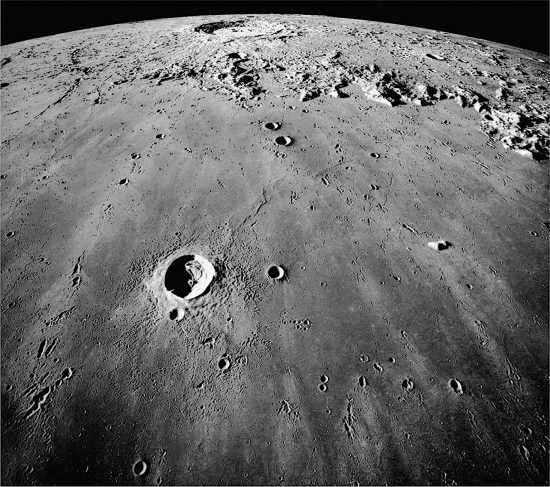September 22, 2020
Previous Pictures of the Day discuss the possibility that there is frozen water on the Moon, although the idea was not given much credence.
The Moon is thought to result from a collision between a planet the size of Mars and Earth. It was torn-out of Earth and, still molten, hurled into orbit. Since it was born in an event that generated immense heat, there should be no water on or inside the Moon: it should all have boiled away.
The Lunar CRater Observation and Sensing Satellite (LCROSS) and the Lunar Reconnaissance Orbiter (LRO) found almost pure ice crystals within craters that are permanently shaded. LCROSS, along with one of its rocket stages, struck Cabeus crater on October 9, 2009. When the explosive cloud rose up to 16 kilometers above the lunar surface, both LCROSS and LRO observed the debris with a variety of sensors. Spectrographic analysis showed water ice in the vapor plume, although it was a small signal.
Water and other volatiles are most likely on the Moon in small amounts because it and the Earth were once part of the same grouping of planets that wandered into the realm of the Sun long ago. We most likely shared a similar birth, with similar chemical gifts. From an Electric Universe perspective, the sparse presence of water on the Moon is not surprising. The catastrophic nature of the Moon’s experiences over the millennia removed most of what was once there, leaving only a pale shadow behind.
The Solar System’s gas giant planets and their accompanying moons suggest that our own Moon might once have been similar: theirs are largely covered in ice. Perhaps what was seen in the deep polar craters on the Moon are all that remains. There is another possibilty, however.
LRO might have detected reflections off the steep crater walls and not ice deposits. Since the radar signature came from both brightly illuminated and darkly shaded areas, it probably bounced off rocks and other debris rather than ice. The Japanese spacecraft, Kaguya found that the south pole craters contain no ice after all.
The floor of Shackleton crater was measured at –183 Celsius, but the Terrain Camera, with a 10 meter resolution, showed no bright, highly reflective patches. The researchers noted that the small excess of hydrogen ions recorded by instruments on previous missions was most likely implanted in the regolith by the solar wind.
In support of the Moon’s aridity, samples brought back by the Apollo missions were predominantly dry. The samples also contained metallic iron, something that should not exist if any appreciable amount of moisture remained in the samples; they should have rusted into iron oxides if water was present in any significant amounts.
Stephen Smith
The Thunderbolts Picture of the Day is generously supported by the Mainwaring Archive Foundation.













